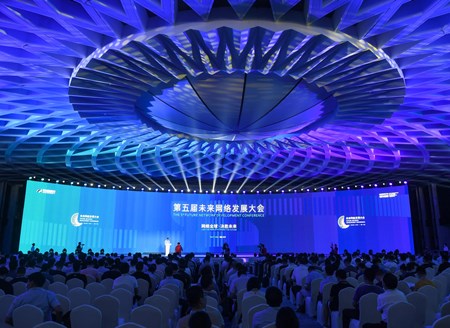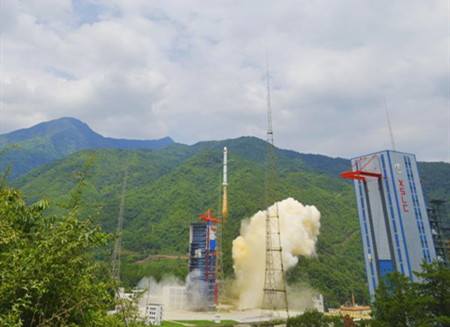
Tourists go shopping at a duty-free shopping mall in Haikou, south China's Hainan Province, Oct. 1, 2021. (Xinhua/Yang Guanyu)
BEIJING, Oct. 1 (Xinhua) -- The Chinese economy is facing multiple challenges including high commodity prices and sporadic COVID-19 cases, with the latest data pointing to slowing consumption growth and contracting factory activity.
A closer look at the economic landscape, however, shows that the resilience and vitality of the world's second-largest economy persist despite headwinds.
The purchasing managers' index (PMI) for China's manufacturing sector came in at 49.6 in September, edging down from 50.1 in August, data from the National Bureau of Statistics (NBS) showed on Thursday. A reading above 50 indicates expansion, while a reading below 50 reflects contraction.
The growth of consumption, a key pillar of China's economy, slowed in August amid new COVID-19 cases and restriction measures, earlier official data showed. Retail sales of consumer goods went up 2.5 percent year on year in August, down 6 percentage points from the previous month.
Floods and sporadic outbreaks of COVID-19 cases have dragged down the growth of consumption and the services industry, and affected progress in investment projects in parts of the country, but China's economy will maintain its recovery momentum, said Li Hui, an official with the National Development and Reform Commission (NDRC).
Citing improvements in flood-hit and epidemic-affected areas, Li said she is confident that the country has capability and conditions to achieve all economic and social development targets in 2021 despite possible fluctuations in certain monthly indicators in the future due to base effects.
Wang Bin, an official with the Ministry of Commerce, noted that the overall momentum of the consumption rebound remains unchanged.
China's retail sales of consumer goods are expected to hit 44 trillion yuan (about 6.8 trillion U.S. dollars) in 2021, up 12.5 percent from last year and 8 percent from 2019, Wang said.
There are plenty of bright spots in the economy. While manufacturing activity contracted in September, the high-tech manufacturing sector maintained steady development, with its PMI rising to 54, the NBS said.
The services sector has also bounced back. The PMI for China's non-manufacturing sector stood at 53.2 in September, returning to the expansion zone after dipping to 47.5 in August.
Foreign trade is seen as a key driver underpinning China's economic resilience. Although the pandemic continued to cloud international trade in August and shipping costs rose, China's imports and exports managed to sustain positive growth for a 15th consecutive month, customs data shows.
Beating expectations, China's export growth in August jumped to 15.7 percent year on year, nearly twice the 8.1 percent expansion seen in July, bolstered by robust global demand.
External trade is expected to continue to perform well in the second half of 2021, though the export growth rate may ease due to base effects, according to the Asian Development Outlook 2021 Update from the Asian Development Bank (ADB).
Foreign direct investment into the Chinese mainland, in actual use, rose 22.3 percent year on year in the first eight months of the year, as foreign investors remained upbeat about the economy's outlook.
The job market remained stable, with the surveyed urban unemployment rate standing at 5.1 percent in August, unchanged from July.
The profits of China's major industrial firms saw steady growth, surging 49.5 percent year on year in the January-August period, official data shows.
International organizations have recently raised or maintained their growth forecasts for China. The World Bank predicted China's economy will grow by 8.5 percent in 2021, up 0.4 percentage points from its April projection, according to its newly released East Asia and Pacific Fall 2021 Economic Update.
The Organisation for Economic Co-operation and Development, in its latest interim economic outlook, said that the Chinese economy is expected to grow by 8.5 percent in 2021, unchanged from its May forecast.
ADB also maintained its projection for China's economic growth, again estimating growth of 8.1 percent in its Asian Development Outlook 2021 Update.
"Growth in China will remain strong," the ADB report said, noting that the gradual recovery of consumption is expected to continue, buttressed by improvements in the job market and consumer confidence.
Aaditya Mattoo, World Bank chief economist for the East Asia and Pacific Region, attributed China's strong recovery to its efficiency in containing the disease, robust exports supported by sustained recovery abroad, and the government's capacity to provide support.
Since the initial COVID-19 outbreak, China has refrained from taking radical stimulus measures. Instead, the country has aimed to maintain the continuity and stability of its macro policies, and make them more targeted and forward-looking.
The country has beefed up monetary and fiscal support for its weak links, such as the rural sector and small firms, and has improved the business environment for all types of enterprises to unleash market vigor.
"China's potential economic growth rate is expected to remain in the range of 5 percent to 6 percent, and the country has the conditions for implementing normal monetary policies," Yi Gang, governor of the People's Bank of China, said in an article recently published in the Journal of Financial Research.






